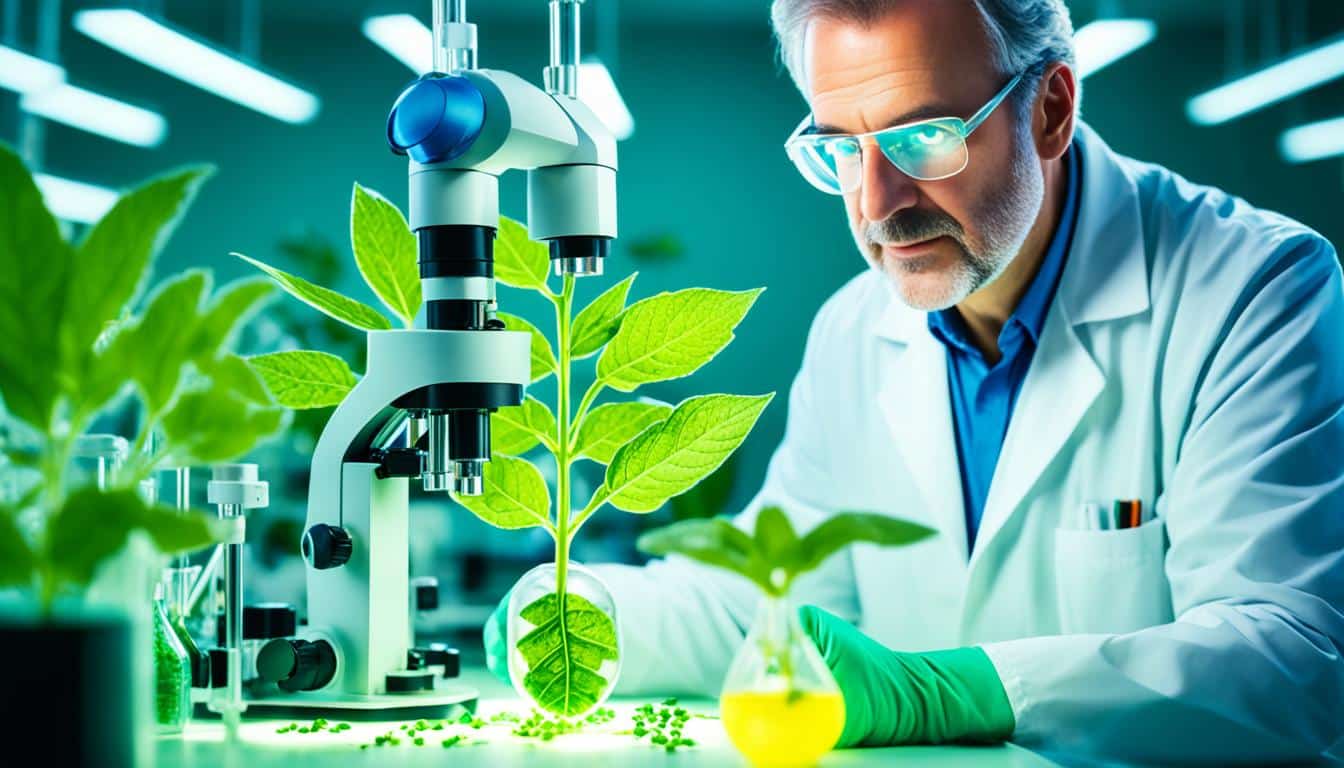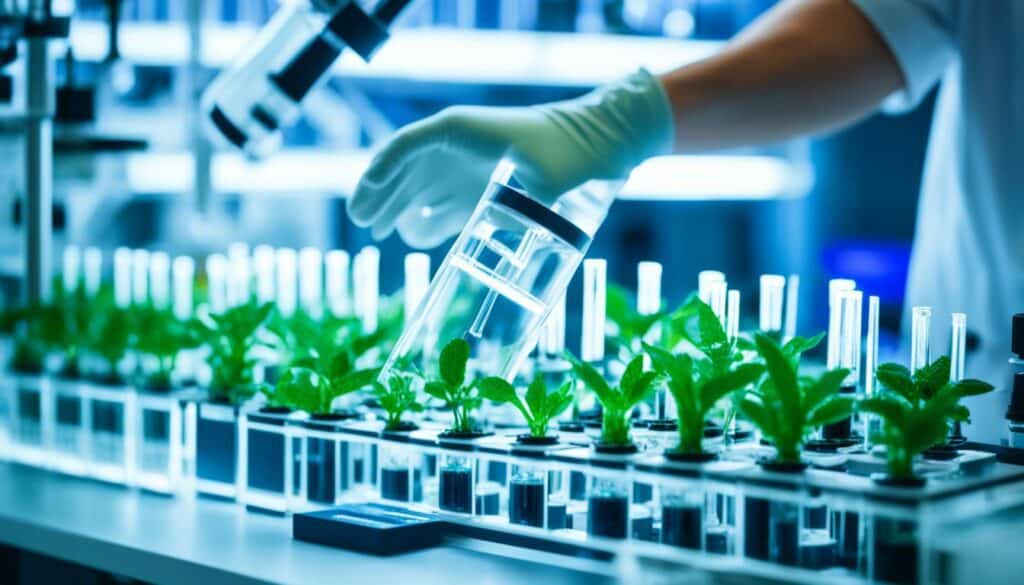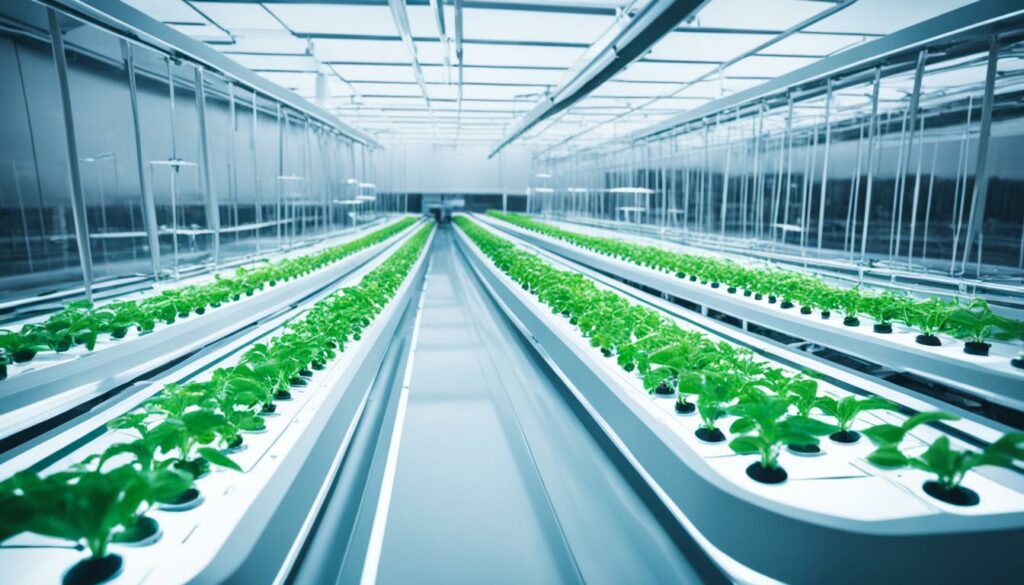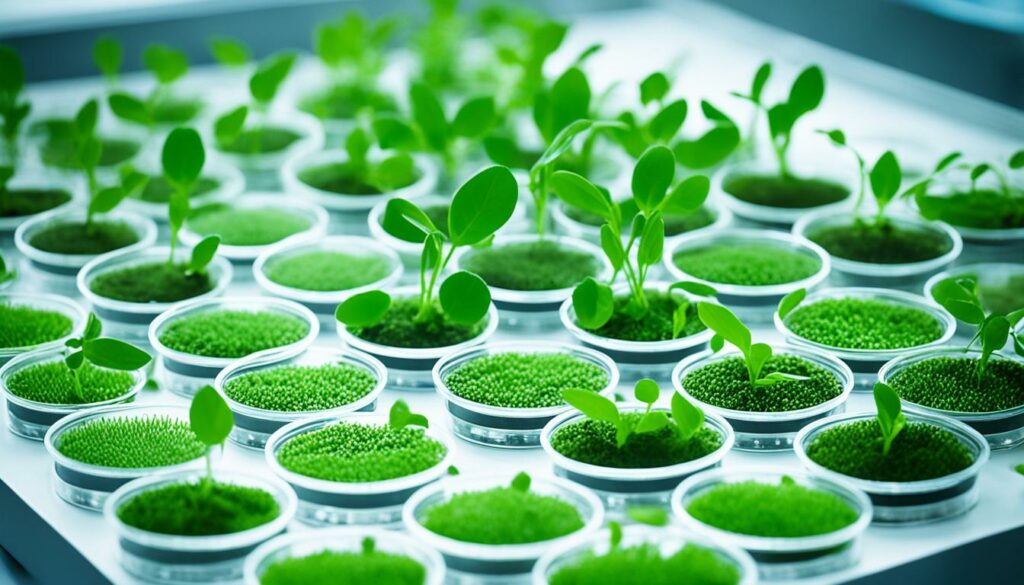Menu

Did you know, despite over 30 years of advancements in plant transformation, many crops still find it hard to change? Sorghum (Sorghum bicolor) is a great example. It’s really hard to transform and regenerate. This shows how complex genetic research is and why we need new methods for improving crops.
Genetic studies in farming are key to tackle food problems as the world’s population grows and the climate changes. Tools like CRISPR/Cas9 let scientists edit crop genes. This makes crops stronger against diseases and better at handling tough conditions. Such tools are changing the way we breed plants, making it more precise and effective.
Also, new tech like single-cell studies and robotic tests could boost how we transform crops. They promise to make the genetic makeover of crops more efficient and precise. This could lead to farming that’s better for the environment and more resilient. It shows how important precision farming is today.
Genetic research in agriculture is changing the game. It’s all about making farming more productive. This helps fight against hunger on a global scale.
Genetic studies deeply impact how well our crops grow, making agriculture sustainable. For example, when hybrid corn was made in the 1930s, corn yields doubled. This trend continued with better wheat and rice in India and China in the 1960s, where yields jumped up to seven times more.
About 500 million people face severe hunger worldwide today. With the world adding more people every year, we need to farm smarter. This means using genetic science to produce more food without harming the planet.
Genetic crop changes began in the late 20th century. Early on, we added new genes in a random way. Today, with tools like CRISPR/Cas9, we can edit genes at specific spots, leading to huge crop improvements. Genetic studies have become a key part of modern farming.
In the U.S., farm productivity has jumped two-and-a-half times in the last 50 years, even as farm areas reduced by 6 percent. This shows how crucial genetic research is for increasing farm output. Notably, crops like maize, wheat, rice, soybeans, and cotton keep producing more each year.
| Year Range | Yield Increase per Year (bushels per acre) |
|---|---|
| 1954-1960 | 2 |
| 1971-1980 | 0.5 |
Plant breeders have found ways to make crops stronger by using genes from wild plants. These efforts focus on better farming, using less water, and surviving disease.
Genetic work isn’t just about making more food; it’s about making food healthier, too. By changing how crops grow, we can fight diseases like heart trouble and diabetes. The goal is to make foods that are better for us.
The path from simple gene changes to today’s advanced tools highlights how crucial genetic work is. It helps us farm in ways that are good for the planet and feed everyone.
The world’s climate is always changing, affecting how well our plants grow. Using genetic research in farming is crucial to finding solutions. It’s vital for making sure we can keep growing food sustainably, especially when the climate is changing so fast.
Climate change makes growing food much harder. More heat, weird rain patterns, and wild weather hurt crops. That’s why we need strong plants that can grow even when facing such tough conditions. Genetic research helps create these resilient crops.

Farmers face many challenges, from weird weather to pest attacks. These can all harm food production. But with the help of modern genetic research, we can make plants tougher. This means we can grow more food, even in difficult conditions.
GM crops show how powerful these technologies can be. They’ve spread rapidly and are proven as safe as regular crops. The safety checks for these crops are very thorough, showing a real dedication to safety (James, 2014).
CRISPR/Cas9 is another game-changer in farming. It allows us to add great traits to plants, like resistance to bugs. These tools, along with others, help us make plants better fit their environments. For example, they can fix gene issues quickly and effectively (Wang et al., 2011).
Dealing with climate change and pests is tough. But, thanks to developments in genetic research, we’re finding better ways to grow food. These technologies keep getting better, offering hope for a more secure food future.
Innovations in plant breeding techniques are leading agricultural progress. These new ways are merging science and tech with old practices. They boost crop quantity and quality a lot. Key methods include hybrid seed technology and precision agriculture solutions.
Hybrid seed technology is changing how we grow plants for the better. It mixes genes from two parent plants to create stronger, healthier hybrids. For example, CIMMYT keeps a wealth of maize and wheat seeds for this. The use of hybrid seeds has spread to over 190 million hectares worldwide.
Precision agriculture solutions use data and tech to make breeding better and manage resources well. This joining of old farming ways and biotechnology in agriculture allows for monitoring and quick action. Remote sensors help measure plant health closely. Molecular breeding methods are then used to speed up creating new, improved plant types.
| Benefits of Innovations | Statistics |
|---|---|
| Improved Wheat Varieties Coverage | 100 million hectares |
| Annual Value Added by Improved Wheat Varieties | $2.8 to 3.8 billion |
| Benefits from Leaf Rust Resistance | $5.36 billion |
| Savings from Stem Rust Disease Control | $1.12 billion annually |
Scientists are making better crop types thanks to molecular breeding methods and New Breeding Techniques. Precision Breeding helps make new plant types quickly and accurately. The mix of hybrid seed technology and precision farming is crucial. It’s making big changes in farming worldwide.
Genome editing technologies lead the field in changing how we pick traits in crops. They change the plant’s genes to make it perform better, especially against diseases and stresses. Scientists say these technologies help make crops that give more food, handle stress better, and are more nutritious.

CRISPR/Cas9 is a top tool because it’s very accurate and works well. But there are four other types of tools for cutting at specific spots: mega-nucleases, zinc finger nucleases, transcriptional activator-like effector nucleases, and CRISPR/Cas system. Each of these can be used to fix genes differently, from just a few changes to adding new genes.
One big plus of genome editing is it’s not seen as risky as making GM crops. Crops edited this way usually have very small DNA changes. This means they might not need as much strict checking before they can be used. So, their good features can quickly help meet the world’s large need for more food. By 2050, we might have over 9 billion people, with 1 billion already not getting enough food.
Many scientists think people will be more open to plants edited this way than those made by moving genes from other species. The chances of unwanted side effects are low, so these tools can be used for many types of plants, even tricky ones. With them, new kinds of crops can be made fast. This helps farming to keep up with changes in the weather and the growing need for more food.
CRISPR/Cas9 has changed the world of genetic research. It starts by making precise cuts in DNA. Then cells fix these cuts in a way that lets us change specific parts of the DNA as we want.
The CRISPR/Cas9 system started in 2012 at the University of California, Berkeley. It uses a guide RNA to take a special protein (‘Cas9’) to where we want to edit the DNA. This is much more accurate than older methods.
CRISPR/Cas9 is great for making crops better. It can improve things like disease fighting and dealing with stress. Some important crops, like rice, wheat, and tomatoes, have already been improved this way.
Since 2012, we’ve been relying more on CRISPR/Cas9 to help with farming challenges. In 2018, we were able to greatly change the DNA of wild tomatoes. This shows how powerful CRISPR/Cas9 is.
CRISPR/Cas9 has a lot of success stories. For example, we’ve made wheat have better grain and made rice and wheat stronger against diseases and stress. In 2011, tomatoes showed more signs of healthy growth thanks to CRISPR/Cas9.
| Year | Advancement | Impact |
|---|---|---|
| 2015 | High-frequency modification of tomato genome | Enhanced mutation breeding |
| 2014 | Simultaneous editing in bread wheat | Improved grain shape and weight |
| 2018 | De novo domestication of wild tomato | Significant trait improvement |
Using CRISPR/Cas9, we’re doing amazing things in farming. It’s making crops better in many ways. This technology is key to ensuring we have enough healthy food for the future and making farming sustainable.
Biotechnology in agriculture has changed how we improve crops, making food more available and sustainable. It uses genetic modification and genome editing to enhance crop traits. Both methods are key in making our food better.

Genetic modification adds new genes randomly to a plant’s DNA. It makes crops better, like making them resist pests more. In the US, most of the corn, cotton, and soybeans in 2012 were this type. These crops are safer for the environment because they can use fewer harmful chemicals.
Genome editing, on the other hand, is very precise. For example, the CRISPR/Cas9 method can change a plant’s DNA exactly how we want. This makes crops healthier, like adding more beta-carotene to rice or changing oil types in plants like canola. It’s a safe way to change plants to meet our needs better and address health issues.
Rules for genetic research differ worldwide, due to concerns over safety and ethics. In the US, strict checks are done to ensure new crops are not harmful. The USDA reports on the use of genetically modified crops, showing steps made and the rules in place.
Different regions view genetic research in various ways. For example, the European Union is very careful, making sure to test everything well and label GMOs. Others might be quicker in adopting new technologies. Creating crops that resist diseases, like the papaya ringspot virus, shows how these efforts can be crucial for some farming sectors.
It is important for global regulations to encourage innovation while keeping things safe and ethical. Ongoing discussions and updating rules are essential for the future of genetic engineering in agriculture.
In today’s farming, choosing the right traits for crops is key. It helps make crops better at fighting diseases and handling stress. This makes them stronger against changing conditions.
Farming techniques today are very different because of new tools like CRISPR Cas-9. These allow us to make disease-fighting crop varieties quicker. These modern methods save time over older ways like backcross breeding.
“Through precise genetic modifications, we can develop crops with robust disease resistance, significantly reducing the reliance on chemical pesticides and enhancing sustainable agricultural practices.”—Expert’s Insight
| Breeding Techniques | Advantages | Applications |
|---|---|---|
| CRISPR Cas-9 | High precision, speed | Targeted disease resistance, tailored trait selection |
| Marker-Assisted Selection | Early seedling stage selection, genotype-based | Disease resistance, stress tolerance |
| Backcross Breeding | Cost-effective, less expertise required | Introgression of specific traits |
Dealing with stress like drought and extreme cold is also crucial. To help crops manage, we use methods such as high-throughput phenotyping. This lets us pick the best plants with stress-fighting qualities.
Using new and old breeding together, we’re making crops tougher. This means our food crops can do better even in tough conditions. It helps move farming towards a more sustainable future.
Molecular breeding methods have changed how we improve crops. They use DNA markers to find and choose the best traits quickly. This technology started in the early 1980s. By 1996, crops with added genes were being sold.

This way of breeding has become common for many crops. It combines new genetic information with old breeding ways. This makes crop varieties better. Techniques like backcrossing and gene pyramiding are important in making crops better.
Advances like CRISPR/Cas9 have made changing genes in plants easier. This has sped up how quickly we can make plants with the traits we want. These changes have been praised in big studies. For example, “Breeding technologies to increase crop production in a changing world” (2010).
Molecular breeding makes choosing young plants using DNA markers possible. This helps avoid growing plants we don’t want. It focuses on making crops that can survive tough conditions. This saves time and money since we don’t have to grow and test as many plants.
Molecular breeding works well in many types of crops. For example, it’s been great for improving wheat. Wheat now has more protein and can survive drought and pests better.
| Aspect | Molecular Breeding | Traditional Breeding |
|---|---|---|
| Speed | Faster | Slower |
| Cost | Cheaper | Costlier |
| Precision | Higher | Lower |
| Scale | High throughput | Lower throughput |
Molecular breeding is key to making better crops quickly. By combining new and old methods, we’re meeting challenges like climate change. These new ways not only move things faster. They also make crops that deal better with the world’s growing food needs.
Nowadays, mixing genetic studies with sustainability is crucial. It helps grow crops that give more food while hurting the planet less. This is a big step in making farming kinder to the earth.
Creating crops that can fight off diseases and deal with tough environments is key to farming well. Through the use of advanced technologies, like finding genes that help plants survive drought, we’re seeing more crops survive and thrive, even when the weather is against them.
Everything points to a future where our careful efforts make everything run smoother. These steps help make sure there’s enough food for all. Also, coming up with smarter ways to deal with pests and diseases is a big deal. This new method looks at how things work on a tiny level. It’s making a big difference in how we grow food without harming the environment.
Mixing genetic research and sustainability means a lot of good things in the long run. We need to grow food in a way that doesn’t spoil our planet. Thanks to new genetic knowledge, we’re getting crops that are better in every way. They yield more, they’re healthier, and they can handle tough situations.
Looking at the bigger picture, farming in smart ways is key. Things like growing plants indoors or in barely any soil are changing the game. They use less land, need less water, and keep nutrients cycling. Yes, they use a lot of power, but they’re showing us new ways to farm. These ways could be the future of growing our food.
| Aspect | Impact |
|---|---|
| Microbial Inoculants | Enhance crop yield by increasing nutrient availability and reducing stress. |
| Alternative Farming Techniques | Optimise space usage and improve resource efficiency. |
| Multi-omics Approaches | Offer tools for crop optimisation, ensuring food security. |
With the world needing more food, these smarter farming ways are our best bet. Moving towards a farm-friendly planet heavily relies on genetic studies. They make sure our farms are strong, productive, and safe for our Earth.
In genetic crop research, overcoming bottlenecks in transforming plants is crucial. The use of CRISPR/Cas tools for editing genomes has opened new doors for plant studies and breeding. However, these tools have not been widely used in plant science due to difficulties in delivering them. This situation calls for new, more efficient methods to help overcome the delivery challenge.

Engineers have made a breakthrough by creating a delivery platform based on a modified tomato spotted wilt virus (TSWV). This virus delivers CRISPR/Cas tools effectively and continuously through plants, allowing for major progress in genetic studies and crop enhancement.
The methods using this virus have shown the power to change genes and DNA bases in various crops. They also help get rid of the virus by using an antiviral treatment. This makes genetic changes more likely to survive in plants, increasing the chances of success.
CRISPR-Cas technology is changing the game in plant research by tackling farming problems, such as low yield and disease resistance. But there are still challenges like safety and social concerns. Progress in plant transformation methods and careful use are key to address these issues.
Advancements in plant synthetic biology (synbio) are crucial for making genetic engineering more precise and efficient. These include editing the genome, designing gene circuits, creating new promoters, stacking genes, and developing sensors. They aim to make farming more sustainable.
Recent advancements in studying cells at a detailed level have revealed how to grow plants better for bioengineering. Yet, making transgenic or gene-edited plants using the traditional method is slow and not very effective for some plant types.
New methods like Fast-TrACC show great promise. They can quickly introduce genes to plant seedlings. This method has proven to be more effective than the usual techniques. Fast-TrACC results in more plant growths and full plants with genetic changes.
With Fast-TrACC, these genetic changes can also be passed on to future plant generations. This helps in breeding better plant varieties. It also allows for experiments to improve how plants develop. Overall, these new methods are pushing the field forward and working towards better crops.
In agriculture, genetics is transforming with single-cell methods and robots. They are changing how we screen genetic data. This means we can make crops better in more precise ways.
Now, we can look at lots of genetic data very quickly thanks to single-cell methods. For example, studies in Nature Methods and Genome Research show how we’ve studied a lot about cells.
Thanks to these breakthroughs, looking at genes is now easier. Tools like 10X Chromium help us look at many cells together. And, robots in farming make sequencing genes and transcripts faster, so we can look at 100 cells at a time.
Robots have made adding new DNA to plants more precise. Together with CRISPR/Cas9, the Leica LMD7, and others, it’s easier to change genes accurately. This speeds up how quickly new plant varieties can be made.
These new methods are also helping with old problems in plant science. Things like waiting a long time for tissue cultures and changing plants being hard are getting better. By using single-cell approaches, we can find the best plant traits more quickly. It helps with making new plants.
| Technique | Platform/Tool |
|---|---|
| Single-Cell RNA-Seq | Smart-seq2 |
| Genome & Transcriptome Sequencing | 10X Chromium |
| Cell Sorting & Collection | BD FACSMelody & BD FACSAria Fusion |
| Single-Cell Isolation | Leica LMD7 |
| Robotic Cell Sorting | Cellenion cellenONE F1.4 |
Combining single-cell methods with robotic tools brings genetic research to new levels. It makes the process in agriculture more efficient and accurate.
Agrobacterium tumefaciens is a key player in turning the science of crop transformation into reality. It offers a trusted way to move genetic material into the cells of plants. This method has been around for over 30 years. Still, getting it right for all crops is tricky. The main issues are getting the genes in and growing new plants from these changed cells. But, there have been big efforts to understand and work through these problems.
New tools like CRISPR/Cas are making us hopeful for better crops. Yet, we often get stuck because it’s hard to grow new plants from the edited cells. This step is crucial for most crops. For them, being able to grow plants from changed cells is like a big door we need to open. Also, getting the gene-editing tools into the plant cells can be tough.
What makes Agrobacterium tumefaciens special is that it’s used a lot in plant changes, whether for a short while or for good. It does this job with a finer touch than many other methods. The process includes making the bacterium attach to the plants, understand signals from the plant, move the DNA, and finally, make the changes in the plant cell. This method can work very well, but its success varies a lot, depending on the plant species.
To make things short, Agrobacterium tumefaciens is still the top choice for working with plant genes. But we need to make it work better to tackle the issues we face. If we can improve how well it delivers the genes and helps the plants grow again, we’ll be in a great position. This will support making better crops and meeting the goals of sustainable farming.
Genetic research is key to increase crop output and fight off challenges. It helps strengthen food safety and economic wellbeing. With tools like CRISPR/Cas9, scientists can precisely improve crops. They work on traits such as fighting diseases and handling stress better.
Over time, genetic modification has moved from adding new sequences at random to precise methods like CRISPR/Cas9. This change started in the late 20th century. Since then, it has helped make crops better at a fast pace.
Changing climate makes it harder for crops. They face more risks from things like drought and pests. Genetic research aims to make crops tough enough to survive these tough conditions.
Hybrid seeds create plants that give more and are of better quality. Precision farming uses data and tech to improve how we sow and grow crops. Together, they help make farming more efficient and effective.
Technologies such as CRISPR/Cas9 can make very specific changes to plant genes by cutting them at exact points. The plants’ natural repair system then adds the desired changes. This makes precise genetic editing possible.
CRISPR/Cas9 has boosted disease defence, stress handling, and yields in crops like rice, wheat, tomato, and maize. These changes have really improved farming’s resilience and productivity.
Traditional genetic modification puts new genes in at random. Genome editing, however, is all about accuracy. It lets us change genes in a very specific way. This makes the process much more refined.
Rules on genetic research differ across the world. There are ongoing discussions about its safety and morality. Each country has its own set of laws on these research tools.
Picking the right traits is crucial to make crops hardier against diseases and stress. It’s done with genetic tools that make changes very precisely. This helps plants fight off dangers and survive harsh environments.
Using DNA markers, molecular breeding finds and selects useful plant traits. It makes the breeding process quicker. It mixes old farming methods with new DNA knowledge to grow better crops.
Genetic research leads to growing more food with less harm to our planet. It helps in achieving sustainable farming. This means more food, less need for resources, and crops that can weather climate change.
Problems like growing new plants and getting editing tools inside them are tough. Researchers are working to make these parts of the process better. They are looking at new methods to grow plants with changed genes more efficiently.
These methods speed up the testing of new traits in plants. They make genetic research quicker and more accurate. By testing faster, we can find new useful plant traits sooner.
Agrobacterium tumefaciens helps move new genes into plant cells. Making its use better can help in more efficient genetic editing. This means making crops better through gene changes more effectively.